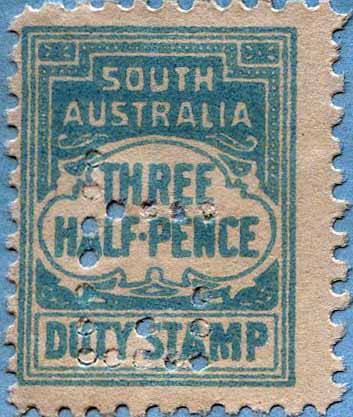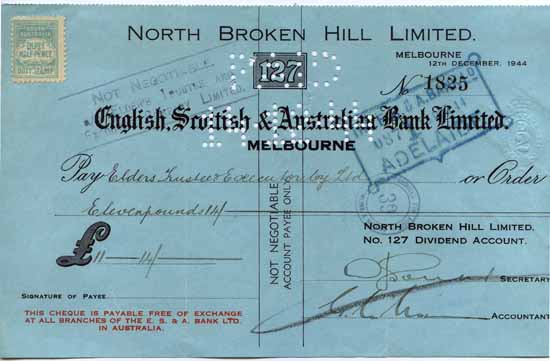|
Private Revenue Perfins of South Australia An Elsmore Coath production The authors would welcome your comments additions or input into this work E -------------------------------------------------------- ET.a
User: Elders Trustee & Executor Co Ltd Trustees Address: 35 Currie St, Adelaide, SA. Revenue Use: 1920 Series 1½d, 2d. Rarity Scale: 1920 Series 1½d R4, 2d R3. Background: *The Elder brothers, William (born March 1813), Alexander (born April 1815), George (born November 1816), and Thomas (later Sir, born August 1818), were born in Kirkcaldy, Scotland, sons of George Elder, a merchant and shipowner. In 1839 the family decided to extend its business interests to the new colony of South Australia and Alexander sailed to Adelaide in the family’s 89 ton schooner “Minerva”. The ship carried a cargo of rum, whisky, brandy, tar, fish, biscuits, tinware, gunpowder, agricultural machinery and seed, the sale of which would establish Alexander as a merchant. On arrival in Adelaide Alexander formed A L Elder & Co as a general and commission agent and the “Minerva” was used as coastal trader mainly on the Adelaide to Launceston route. Between 1841 and 1843 Alexander expanded his activities to include farming, gas production, metal broking and a Shipping Agency. Alexander’s older brother William, a sea captain, visited Adelaide in 1840 when he brought out 183 Scottish and Irish migrants but he returned with his wife to join the family business in 1844. In 1849, George joined his brothers in Adelaide after some years spent in Canada. This meant a change to the company structure and it was renamed Elder & Co in 1853. In 1855 Alexander moved to London and re established A. L. Elder & Co. which acted as a buying office for the Adelaide business (until 1884) as well as a general agent. Alexander died in 1885 and his London business was continued by his sons. William left Adelaide soon after Alexander and retired to Scotland. He died at Cannes in April 1882. George also left Adelaide in 1855 to live in Scotland, where he died in July 1897. Thomas migrated to Adelaide in 1854 and worked for a year with George before starting a partnership with Edward Stirling, Robert Barr Smith and John Taylor, titled Elder, Stirling & Co in 1856. In 1859 the company helped to finance the establishment of the Wallaroo and Moonta Copper Mines. This proved to be an excellent investment and Stirling and Taylor retired and in 1863 the two remaining partners formed Elder Smith & Co. As they expanded their brokerage and shipping interests Elder Smith also built up large pastoral territory particularly in remoter parts of South Australia, Queensland and Western Australia. Thomas was a member of the Legislative Council in 1863-69 and 1871-78. For his business, philanthropic and political achievements he was knighted with a K.C.M.G. in 1878 and G.C.M.G in 1887. Thomas died in March 1897 and the company was restructured as Elder Smith & Co Ltd in 1888. Thomas never married and had no children, so Elder Smith and Co Ltd continued under the management of Thomas’s long time partner, Robert Barr Smith. In 1910 the company created the Elder's Trustee and Executor Co Ltd with the view of offering Trustee services to the large client base that they had in the parent company. Robert Barr Smith died in November 1915 but the Barr Smith family maintained its links to Elders Smith & Co Ltd with Tom Elder Barr Smith (1863–1941) serving as Chairman from 1921 and later his son Sir Tom Elder Barr Smith (1904–1968) being a Director from 1941. Elders had acquired George Hague and Co in 1937, Victoria’s second biggest Wool auction centre. This allowed Elders to enter the major wool centre of Geelong, making a significant impact on Elders market share in the wool industry. By 1939 Elders had principal offices in Adelaide, Perth, Melbourne, Sydney, Brisbane, Geelong and London. In addition it had 38 country branches in SA, 25 in WA and 2 in NSW, at Broken Hill and Wentworth; was agent for a dozen shipping companies, including P&O and was a ship charterer in its own right. It was the agent for six airlines, establishing Elders Travel and was either Australian or SA agent for more than 80 manufacturers, most of whom made products for the company’s farmer and pastoralist clients. In addition Elders expanded its banking business for rural clients lending for seasonal finance, working capital, machinery purchases, stock and crop liens or property loans. After World War 2 the company sought to expand its wool market share through an aggressive acquisition strategy and by the 1950’s Elders were the largest wool brokerage in Australia. This was cemented with the 1962 merger with Goldsbrough Mort. The merged company was the market leader, eclipsing long time rival Dalgety and this allowed the company to expand its mining interests as well as launching the Elders Finance and Investment Co. in 1970. As mentioned above, in 1910 the company had created the Elder's Trustee and Executor Co Ltd. The concept of Trustee companies had been growing in each of the States since the mid 1880’s and this lead to the passing of various State Legislation and the establishment of a small group of approved Trustee companies in each State. Such Trustee companies provided a range of financial management services, but principally they focused on estate planning, administering deceased estates, managing the financial affairs of persons unable to look after their own interests, and administering charitable trusts and foundations. With respect to Elders the associated legislation was the "Elder’s Executor Company’s Act 1910" and this remained in place until the review of the Act in 1988. In 1982 Elders assumed control of the Elder's Trustee and Executor Co Ltd. The combined company later became Elders IXL in 1982. Device: Both Elder’s Trustee and Executor Co Ltd and the parent company were perfin users but only Elders Trustee and Executor Co Ltd used perfins on revenue stamps. The ET.a device is most likely a single die device. We have not sighted multiples to confirm this but the device seems capable of producing single and central strikes on a variety of stamp formats and this is a characteristic of single die devices. It is found used on postage stamps from 1932 until at least late 1951 (possibly into 1952). However usage on revenue stamps is rare. There is no reported usage on Railway stamps. Related patterns: There were Elder Smith & Co. Ltd patterns used on postage stamps but not revenues, as follows: ES/&CO/LTD Adelaide 1906–1920 ES (modification of ES/&CO/LTD above) Adelaide 1921-1949 ES/&CO/LTD Perth 1921-1937 Related patterns: Refer to Goldsbrough Mort & Co Ltd patterns in: SA: G.a and G.b GM/&Co/LTD.a GM/CO/LTD.a, GM/CO/LTD.b Other – SA: Section 2 Commercial Overprints ELDER SMITH & CO. LIMITED.a *Australian Dictionary of Biography *Elders website *Wikipedia -------------------------------------------------------- |


